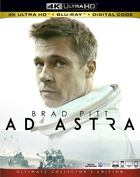BLU-RAY REVIEW

Ad Astra 4K Ultra HD
Featured In Issue 247, January 2020
Set in space, "Ad Astra" tells the story of a mysterious life-threatening event, which strikes Earth. Astronaut Roy McBride (Pitt) goes on a dangerous mission across an unforgiving solar system to uncover the truth about his missing father (Jones) and his doomed expedition that now, 30 years later, threatens the universe. (Gary Reber)
Special features include commentary by Director James Gray; two deleted scenes with optional commentary by Gray (HD 03:25); five feaurettes: "To The Stars" (HD 08:35), "A Man Named Roy" (HD 08:45), "The Crew Of The Cepheus" (HD 09:08), "The Art Of Ad Astra" (HD 11:15) and "Reach For The Stars" (HD 07:21); upfront previews and a Movies Anywhere digital code.
The 2.39:1 2160p HEVC/H.265 Ultra HD HDR10/Dolby Vision picture, reviewed on a Sony Bravia Z9D 4K Ultra HD HDR display, was photographed in anamorphic Techniscope on Kodac Vision3 film stock and digitally using the Aton Penelope, Arri Alexa XT Infrared, Arricam LT, Arricam ST and Arriflex 435 Advanced camera systems and sourced from a 2K (not 4K) master Digital Intermediate format. As the 2K Digital Intermediate has been upconverted to 2160p, there is no real gain in native resolution. Film grain is virtually non-existent. HDR contrast is exceptional, with deep space blacks contrasting with bright accent lighting emitting from the spacecraft, bright spacecraft interiors, and excellent shadow delineation. Color fidelity is excellent with a wide color gamut displaying a wide range of prominent whites, from astronaut suits to spaceship interiors. Spot colors are nicely saturated, The range of color is at times superb. Fleshtones exhibit accuracy throughout. The visual effects are impressive. In one sequence in a comfort room, color images pop out on video walls. The production design depicting the "machines" that comprise the spacecraft, space stations and outposts are incredibly realistic. The planet surfaces are hauntingly beautiful. Resolution is excellent, with very fine detail exhibited throughout, especially during close-ups of facial features, such as skin pores, lines, beard stubble and hair, and costumes and object textures.
WOW! segments are 04:35 to 08:38, 25:42 to 30:40, 42:42 to 44:44, 01:01:14 to 01:03:41, 01:26:35 to 01:30:00 and 01:36:08 to 01:39:50.
The picture is impressively natural in appearance throughout, for a reference-quality experience. (Gary Reber)
The Dolby Atmos/Dolby TrueHD 7.1-channel soundtrack is effectively dynamic sounding, with a wide range of energy, from rocket engine blasts to very nuanced quiet moments. Deep bass extension in all channels and the .1 LFE is prominent throughout, especially during intense solar disturbances and rocket engine ignition and shut-down sequences. Bass extends to sub-25 Hz, often with intense energy. The orchestral music score floats across and within the soundstage, extending to envelop the soundfield. Foley sound effects are realistic. Atmospherics enhance the sense of realism both on earth, in space, and in space stations. Sound effects are dynamic sounding and bolstered by bass enhancement. Dialogue is intelligible throughout with degrees of spatial integration, including Maj. McBride's inner thoughts narration, which is nicely forward sounding.
The Immersive Sound element is comprised of the extension of the orchestral score throughout. Occasional dialogue extension of McBride's inner thoughts and remembrances of his wife's feelings, and space station and spacecraft announcements are other elements. Sound effects such as all manner of rocket blasts to warning sirens and subtle atmosphericas play an effective part of the height layer, to create drama and tension. This is an effective Immersive Sound presentation that is well crafted.
This is a powerful soundtrack experience and a torture test for subwoofers in a good home theatre system. (Gary Reber)

 then "Add to Home Screen"
then "Add to Home Screen"